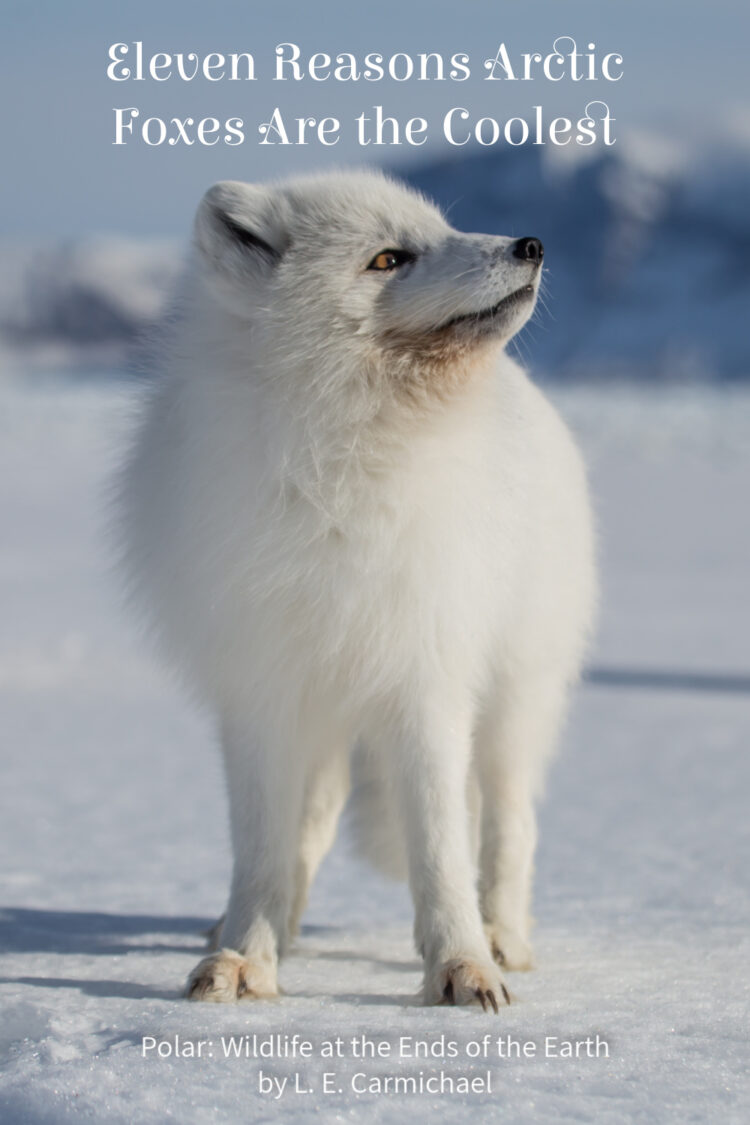 I learned about a LOT of amazing animals while researching Polar: Wildlife at the Ends of the Earth, but arctic foxes will always have a special place in my heart. One reason is that I spent 6 years studying them (and wolves) for my PhD. The other reason is that arctic foxes are COOL. Here’s why.
I learned about a LOT of amazing animals while researching Polar: Wildlife at the Ends of the Earth, but arctic foxes will always have a special place in my heart. One reason is that I spent 6 years studying them (and wolves) for my PhD. The other reason is that arctic foxes are COOL. Here’s why.
1) Look at that little face! This critter knows exactly how cute it is. Notice how its nose and ears are stubby compared to those of other foxes. Those are adaptations that help keep the heat in during a frigid Arctic winter.
2) Arctic foxes have fur on their toe pads (not just in between their toes), which protects them from snow and ice. They are the only member of the canine family with furry feet. They are also the only canine with a seasonal colour change.
3) Foxes sleep in “ball form,” curled up so that only their fuzzy bits are exposed to the elements. In the wild, the temperature difference between the inside of a balled-up fox and the outside air can be up to 52.5 C!
4) In one lab experiment, and arctic fox kept a -80 C for one hour shivered, but maintained its normal body temperature. Do NOT try that at home, kids!
5) Arctic foxes have been known to keep warm by hollowing out reindeer carcasses and crawling inside. Kind of like Luke Skywalker in a Tauntaun.
6) In most parts of the arctic, their primary food is lemmings. Every four years(ish) the lemming population crashes, and foxes have to find other food supplies. In the opening scene of Polar, a fox is following a polar bear’s trail, hoping to steal his leftovers. This is a popular strategy, though not without risk. Hungry bears do occasionally eat the fox…
7) Fox mothers adjust the size of their litters – in the womb – to match available food resources. In a good lemming year, they can have as many as 24 pups.
8) On Mednyi Island, where female pups inherit their mom’s territory and male pups disperse to find their own, fox mothers can adjust the sex ratio of their litters to match food resources. Moms in good territories have more girls, and moms in poor territories have more boys. AMAZING.
9) One of my own studies showed that, in some conditions, fox moms share dens so they have extra adults to care for their pups. One mom can also have a mixed litter of pups with different fathers. This helps increase genetic diversity in the young, a good strategy when environmental conditions are changeable. With luck, at least one of those pups will have the right mix of traits to surviving in its surroundings.
10) In 2019, scientists tracked a fox that traveled 3506 km in 76 days (the previous record was 2300 km in a single winter). That is really impressive when you consider how short their legs are! Polar connection: one of the scientists who made this discovery is Eva Fugeli. Eva and I collaborated on fox research when I was a graduate student, and she was kind enough to provide an expert review for the book.
11) Arctic foxes grow gardens! Like beavers and elephants, they are ecosystem engineers, changing their habitats in ways that affect a lot of other species. Prey carcasses and fox droppings collect around dens, leading to plant growth so lush, scientists can spot dens from the air. The gardens are also prime lemming habitat – in Polar, a litter of baby lemmings snoozes under such a garden.
Do you have a favourite fox? What’s your favourite Arctic animal, and why? Share in the comments!
Eight more sleeps until Polar: Wildlife at the Ends of the Earth hits bookstore shelves! Pre-order a copy from your local independent bookstore to reduce your carbon footprint AND support a cornerstone of your community. You can also order from your favourite online retailers.
Don’t forget to check my Public Appearances page for Polar virtual events and live events happening near you! Are you a teacher or librarian? I’m available for author visits in May and June – contact me to secure your spot.